Respirator Trusted-Source Information
Section 1: NIOSH-Approved Respirators
How can they be identified?
How are NIOSH-Approved Particulate Filtering Respirators Classified?
Your employer may have told you that respiratory protection is needed because of inhalation hazards from airborne particles, which may include infectious agents. NIOSH-approved particulate filtering respirators can be used to protect you from these hazards. It is important for you to understand the classification system of NIOSH-approved respirators that use filters to remove particles from the air that is breathed through them.
There are ten classes of NIOSH-approved particulate filtering respirators available at this time. 95% is the minimal level of filtration approved by NIOSH. The N, R, and P designations refer to the filter’s oil resistance as described in the table below.
| Filter Class | Description |
|---|---|
| N95, N99, N100 | Filters at least 95%, 99%, 99.97% of airborne particles. Not resistant to oil. |
| R95, R99, R100 | Filters at least 95%, 99%, 99.97% of airborne particles. Somewhat resistant to oil. |
| P95, P99, P100 | Filters at least 95%, 99%, 99.97% of airborne particles. Strongly resistant to oil. |
| HE (High Efficiency Particulate Air) | Filters at least 99.97% of airborne particles. For use on PAPRs only. PAPRs use only HE filters. |
The two most common configurations for particle filtering respirators are filtering facepieces and elastomerics. As the name implies a filtering facepiece respirator is one in which the facepiece is comprised of the filter material. Two examples of filtering facepiece respirators are the cup style (see Figure 1), and the flat fold type (see Figure 2). Elastomeric respirators are comprised of a molded facepiece to which replaceable filtering cartridges are attached (see Figure 3).
Figure 1 – Filtering facepiece respirator, preformed type.
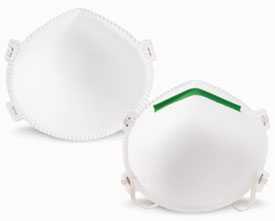
Figure 2 – Filtering facepiece respirator, flat fold type.
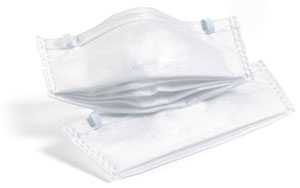
Figure 3 – Elastomeric respirator.
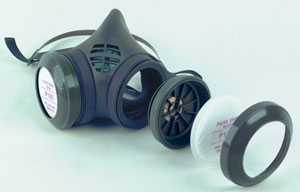
Markings and Approval Labels
When it comes to knowing if your respirator has a NIOSH approval, the label is important.
If you know what to look for, identifying approved respirators should not be too difficult.. All NIOSH-approved respirators have an approval number. With few exceptions the NIOSH approval number is not on the respirator itself, but on a separate NIOSH approval label which is found on, or within the packaging. An example of this type of NIOSH label is shown in Figure 4. The approval number is shown in red, and the protection is shown in blue, N95 on this example. The NIOSH approval number and approval label are your keys to identifying NIOSH-approved respirators. Respirator approvals are occasionally revoked. If this should happen, NIOSH sends a User Notice to all NIOSH NPPTL listserv subscribers and removes the approval number from NIOSH listings of approved respirators. However, inventories of the revoked respirators still may be available for purchase or consumers may have them on hand from an earlier purchase. You may readily verify that respirator approvals are valid by checking the information links on the NIOSH Trusted-Source page, or in the NIOSH Certified Equipment List (CEL). Users are encouraged to self-subscribe to the NIOSH listserv service to receive User Notice email notifications concerning the status of respirator approvals and other relevant information.
Both an approval label and user instructions are supplied with all NIOSH-approved respirators. These documents, a single copy of which may accompany either a large or small package of respirators, should not be discarded before all of the respirators are used or discarded. In addition to the approval number, the NIOSH approval label contains contact information for the respirator manufacturer/supplier, cautions, and limitations for use, and directions for proper use. It is very important to read and follow all of the manufacturer’s instructions for the particular respirator that you are using.
Some filtering facepiece respirators are exceptions to the assumption of the approval number not appearing directly on the respirator. Figure 5 below shows typical markings on approved filtering facepiece respirators. The markings shown in red are present on all NIOSH-approved filtering facepiece respirators, although they may appear either on the face, on the exhalation valve (if one exists), or on the head straps. The markings shown in black may or may not be on the respirator at all. The model or part number marked on the respirator will also appear on the approval label.
Figure 4 – Example of NIOSH approval label.
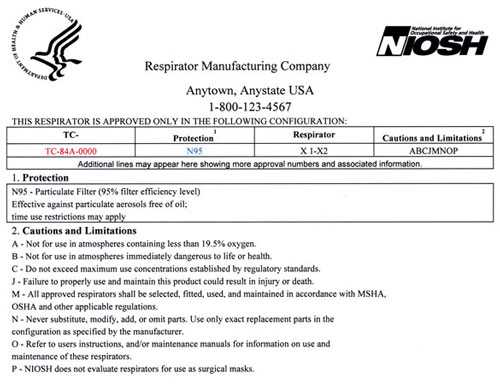
Figure 5 – Example of typical markings on approved filtering facepiece respirators.
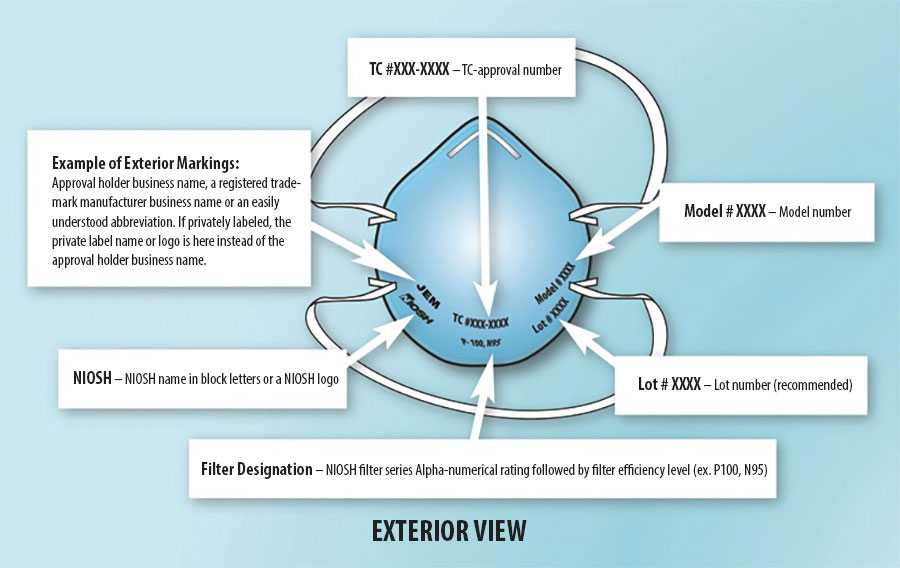
- Page last reviewed: October 12, 2017
- Page last updated: August 18, 2016
- Content source:
- National Institute for Occupational Safety and Health National Personal Protective Technology Laboratory


 ShareCompartir
ShareCompartir